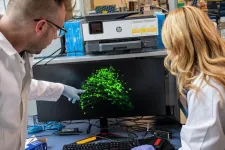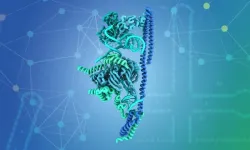(Press-News.org) A new study explores how complex chemical mixtures change under shifting environmental conditions, shedding light on the prebiotic processes that may have led to life. By exposing organic molecules to repeated wet-dry cycles, researchers observed continuous transformation, selective organization, and synchronized population dynamics. Their findings suggest that environmental factors played a key role in shaping the molecular complexity needed for life to emerge. To simulate early Earth, the team subjected chemical mixtures to repeated wet-dry cycles. Rather than reacting randomly, the molecules organized themselves, evolved over time, and followed predictable patterns. This challenges the idea that early chemical evolution was chaotic. Instead, the study suggests that natural environmental fluctuations helped guide the formation of increasingly complex molecules, eventually leading to life’s fundamental building blocks.
A new study led by Dr. Moran Frenkel-Pinter, from the Institute of Chemistry at The Hebrew University of Jerusalem, as well as Prof. Loren Williams, from the Georgia Institute of Technology, investigates how chemical mixtures evolve over time, shedding light on potential mechanisms that contributed to the emergence of life on Earth. Published in Nature Chemistry, the research examines how chemical systems can undergo continuous transformation while maintaining structured evolution, offering new insights into the origins of biological complexity.
Chemical evolution refers to the gradual transformation of molecules in prebiotic conditions, a key process in understanding how life may have arisen from non-living matter. While much research has focused on individual chemical reactions that could lead to biological molecules, this study establishes an experimental model to explore how entire chemical systems evolve when exposed to environmental changes.
The researchers used mixtures containing organic molecules with diverse functional groups, including carboxylic acids, amines, thiols, and hydroxyls. By subjecting these mixtures to repeated wet-dry cycles—conditions that mimic the environmental fluctuations of early Earth—the study identified three key findings: chemical systems can continuously evolve without reaching equilibrium, avoid uncontrolled complexity through selective chemical pathways, and exhibit synchronized population dynamics among different molecular species. These observations suggest that prebiotic environments may have played an active role in shaping the molecular diversity that eventually led to life.
“This research offers a new perspective on how molecular evolution might have unfolded on early Earth,” said Dr. Frenkel-Pinter. “By demonstrating that chemical systems can self-organize and evolve in structured ways, we provide experimental evidence that may help bridge the gap between prebiotic chemistry and the emergence of biological molecules.” Beyond its relevance to origins-of-life research, the study’s findings may have broader applications in synthetic biology and nanotechnology. Controlled chemical evolution could be harnessed to design new molecular systems with specific properties, potentially leading to innovations in materials science, drug development, and biotechnology.
END
How Earth's early cycles shaped the chemistry of life
2025-02-12
ELSE PRESS RELEASES FROM THIS DATE:
Ukraine war forces planes to take longer routes, raising CO2
2025-02-12
Global aviation carbon dioxide emissions increased by 1% in 2023 because planes had to fly longer routes to avoid Russian airspace, according to a new study.
After Russia invaded Ukraine in February 2022, Western airlines were banned from flying over Russia. This forced them to take much longer routes between Europe or North America and East Asia, burning more fuel in the process.
Published today (Wednesday, 12 February) in Communications Earth & Environment, the study found that detours caused by the Ukraine war led to planes using 13% more fuel on average compared to their original routes. The impact was even greater for flights between Europe and Asia, which saw a 14.8% increase in ...
Negative refraction of light using atoms instead of metamaterials
2025-02-12
For the first time, scientists have demonstrated that negative refraction can be achieved using atomic arrays - without the need for artificially manufactured metamaterials.
Scientists have long sought to control light in ways that appear to defy the laws of Nature.
Negative refraction - a phenomenon where light bends in the opposite direction to its usual behaviour - has captivated researchers for its potential to revolutionise optics, enabling transformative technologies such as superlenses and cloaking devices.
Now, carefully ...
High BP may develop at different ages and paces in East & South Asian adults in the UK
2025-02-12
Research Highlights:
A data analysis projected that South Asian adults living in the United Kingdom may experience elevated blood pressure nine years earlier than East Asian adults on average.
The largest blood pressure disparities between South Asian and East Asian adults were projected to be in 18-39-year-old men and 40–64-year-old women.
The projected increase in systolic blood pressure in middle age East Asian adults was linked to a nearly 2.5 times higher risk for heart disease caused by blocked arteries and a nearly fourfold greater risk of stroke. Even at an older age, high systolic ...
Meet the newly discovered brain cell that allows you to remember objects
2025-02-12
Take a look around your home and you’ll find yourself surrounded by familiar comforts—photos of family and friends on the wall, well-worn sneakers by the door, a shelf adorned with travel mementos.
Objects like these are etched into our memory, shaping who we are and helping us navigate environments and daily life with ease. But how do these memories form? And what if we could stop them from slipping away under a devastating condition like Alzheimer’s disease?
Scientists at UBC’s faculty of medicine have ...
Engineered animals show new way to fight mercury pollution
2025-02-12
Australian scientists have found an effective new way to clean up methylmercury, one of the world’s most dangerous pollutants, which often builds up in our food and environment because of industrial activities such as illegal gold mining and burning coal. The discovery, published in Nature Communications on 12 February 2025, could lead to new ways of engineering animals to protect both wildlife and human health.
The research team from Macquarie University's Applied BioSciences, CSIRO, Macquarie Medical School, and the ARC Centre of Excellence in Synthetic Biology, has successfully genetically modified fruit flies and zebrafish to transform methylmercury into a ...
The 3,000-year coral reef shutdown: a mysterious pause and a remarkable recovery
2025-02-12
New study reveals that coral reefs in the Gulf of Eilat experienced a surprising 3,000-year "shutdown" in growth, from about 4,400 to 1,000 years ago, likely due to a temporary drop in sea level that could have been caused by global cooling. This phenomenon, which aligns with similar reef interruptions in Mexico, Brazil, and Australia, suggests a widespread environmental shift during that period. Despite the long pause, the reef eventually recovered, with coral species reappearing from deeper ...
Worm surface chemistry reveals secrets to their development and survival
2025-02-12
A new study has revealed the clearest-ever picture of the surface chemistry of worm species that provides groundbreaking insights into how animals interact with their environment and each other. These discoveries could pave the way for strategies to deepen our understanding of evolutionary adaptations, refine behavioural research, and ultimately overcome parasitic infections.
Scientists from the University’s School of Pharmacy used an advanced mass spectrometry imaging system to examine the nematodes Caenorhabditis elegans and Pristionchus pacificus, aiming to characterise species-specific surface chemical ...
Splicing twins: unravelling the secrets of the minor spliceosome complex
2025-02-12
In human cells, only a small proportion of the information written in genes is used to produce proteins. How does the cell select this information? A large molecular machine called the spliceosome continuously separates the coding and non-coding regions of our genes – and it's doing this even as you read these lines.
The spliceosome is critical for the proper functioning of every cell, and numerous genetic disorders are linked to problems with spliceosome function. In most eukaryotic cells, two types of ...
500-year-old Transylvanian diaries show how the Little Ice Age completely changed life and death in the region
2025-02-12
Glaciers, sediments, and pollen can be used to reconstruct the climate of the past. Beyond ‘nature’s archive,’, other sources, such as diaries, travel notes, parish or monastery registers, and other written documents – known at the ‘society’s archive’ – contain reports and observations about local climates in bygone centuries.
In contrast, the second half of the century was characterized by heavy rainfall and floods, particularly in the 1590s.
The western parts of the European continent cooled significantly when in the 16th century a period known as the ‘Little Ice Age’ intensified. During the second ...
Overcoming nicotine withdrawal: Clues found in neural mechanisms of the brain
2025-02-12
According to the World Health Organization (WHO), over 22% of the global population smokes, with more than 9 million smoking-related deaths reported annually. Effective treatments to alleviate nicotine withdrawal symptoms caused by smoking cessation are essential for successful smoking cessation. Currently, approved treatments for nicotine withdrawal include Bupropion and Varenicline, but there is a pressing need for new therapeutic options to improve smoking cessation success rates.
The research team led by Dr. Heh-In Im at the Center for Brain Disorders of the Korea Institute of Science and Technology (KIST) has identified a novel brain region and neural mechanism ...






